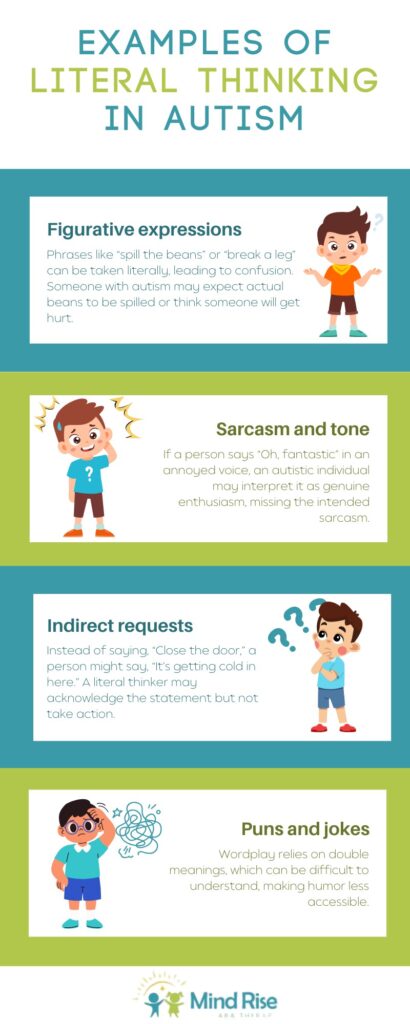Key Points:
- People with autism often interpret language literally due to differences in cognitive processing.
- Challenges with figurative speech stem from differences in social communication and language comprehension.
- ABA therapy helps individuals with autism develop flexible thinking and improve language skills.
Ever told a joke, only to have your child take it literally? Many autistic individuals struggle with figurative language, leading to confusion in daily conversations. Understanding why this happens can help parents and caregivers communicate more effectively and support their child’s social development.
Why Do People with Autism Take Things Literally?
Autism taking things literally is common due to differences in how the brain processes language. Many individuals on the autism spectrum struggle with figurative speech, idioms, sarcasm, and implied meanings. This happens because they often rely on direct, concrete interpretations of words rather than inferred or implied meanings.
While neurotypical individuals naturally grasp sarcasm, jokes, and metaphors, those with autism may need explicit explanations. This is not due to a lack of intelligence but rather a different way of processing language and communication.
The Connection Between Autism and Literal Thinking
Many autistic individuals thrive on precision and predictability. Their cognitive processing style favors logic, facts, and clear rules. This preference makes it difficult to interpret language that relies on nuance, tone, or context.
Several factors contribute to this:
- Differences in brain structure and function – Studies show that autistic brains process language differently, often focusing more on details than abstract concepts.
- Difficulty with the theory of mind – Many autistic individuals struggle to predict what others are thinking or feeling, making it hard to infer implied meanings.
- Preference for consistency – Concrete language aligns with the structured thinking patterns that many autistic people prefer.
Understanding these challenges can help parents and caregivers communicate more effectively with individuals on the spectrum.
Examples of Literal Thinking in Autism
Literal thinking appears in many everyday situations, often causing confusion in conversations. Autistic individuals may struggle to interpret implied meanings, figurative speech, or humor. Here are some common examples:

How Literal Thinking Affects Social Interactions
Literal thinking can make social interactions challenging because conversations often rely on implied meanings, sarcasm, and humor. When an autistic individual takes words at face value, they may misunderstand jokes, idioms, or indirect requests, leading to confusion or miscommunication. This can make it difficult to engage in casual conversations or group discussions.
In social settings, people frequently expect others to “read between the lines.” An autistic person may struggle with this, responding in ways that seem unexpected or inappropriate. For example, if someone says, “I could eat a horse,” a literal thinker might take that statement seriously rather than understanding it as an exaggeration.
These misunderstandings can sometimes lead to frustration, withdrawal, or even social isolation. Peers may misinterpret their responses as being rude or disinterested. However, with the right support—such as explicit communication strategies and social skills training—autistic individuals can develop better tools for navigating social interactions with confidence.
Strategies to Support Literal Thinkers
Helping an autistic individual navigate figurative language requires patience and intentional teaching. Here are some effective strategies:
- Use clear and direct language – Instead of “Can you keep it down?” say “Please lower your voice.”
- Explain idioms and expressions – Teach common phrases and their meanings with real-life examples.
- Use visual aids – Diagrams, charts, or written explanations can reinforce abstract concepts.
- Encourage clarifying questions – Teach individuals to ask, “Do you mean literally or figuratively?” when uncertain.
- Practice with social stories – Role-playing common situations can help build understanding.
These strategies make communication more accessible and reduce confusion for autistic individuals.

How ABA Therapy Helps with Language Comprehension
ABA therapy is a proven approach that helps autistic individuals develop essential communication skills. It focuses on structured learning to improve understanding of both literal and figurative language.
One key benefit of ABA therapy is teaching flexible thinking. Many autistic individuals struggle with shifting between literal and non-literal meanings. Therapists use targeted exercises to help them recognize different language patterns.
Another focus is comprehension through repetition. ABA therapy breaks down complex language into manageable steps. Practicing idioms, sarcasm, and indirect requests repeatedly helps individuals gradually grasp abstract concepts more easily.
ABA therapy also teaches self-advocacy strategies. Children learn to ask clarifying questions when they don’t understand something. This skill helps them feel more confident in conversations and social interactions.
With consistent ABA therapy, autistic individuals gain the tools to navigate language more effectively, reducing frustration and improving communication skills in everyday life.
Get Expert Support with ABA Therapy
If your child struggles with autism taking things literally, professional support can make a significant difference. Mind Rise ABA provides expert ABA therapy to help children improve language comprehension, social interactions, and flexible thinking.
Our team in Virginia is dedicated to providing personalized ABA therapy tailored to your child’s unique needs. Contact Mind Rise ABA today to learn more about our ABA therapy services in Virginia and how we can support your child’s development.

